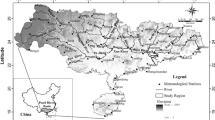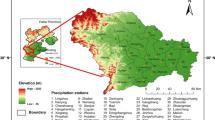Abstract
Precipitation, a natural feature of weather systems in the Earth, is vitally important for the environment of any region. Under global climate change condition, the characteristics of precipitation have changed as a consequence of enhanced global hydrological cycle. The source region of the Yellow River (SRYR), locating within the Qinghai-Tibet Plateau, is sensitive to the global climate change due to its complex orography and fragile ecosystem. To understand the precipitation characteristics and its impacts on the environment in the region, we studied the characteristics of rainy days and precipitation amount of different precipitation classes, such as light (0–5 and 5–10 mm), moderate (10–15, 15–20 and 20–25 mm) and heavy (≥25 mm) rains by analyzing the precipitation data of typical meteorological stations in the SRYR during the period 1961–2014, as well as the trends of persistent rainfall events and drought events. Results showed that annual average precipitation in this area had a non-significant (P>0.05) increasing trend, and 82.5% of the precipitation occurred from May to September. Rainy days of the 0–5 mm precipitation class significantly decreased, whereas the rainy days of 5–10, 10–15, and 20–25 mm precipitation classes increased and that of ≥25 mm precipitation class decreased insignificantly. The persistent rainfall events of 1- or 2-day and more than 2-day showed an increasing trend, with the 1- or 2-day events being more frequent. Meanwhile, the number of short drought periods (≤10 days) increased while long drought periods (>10 days) decreased. Since the 0–5 mm precipitation class had a huge impact on the grasslands productivity; the 5–10, 10–15, and 20–25 mm precipitation classes had positive effects on vegetation which rely on the deep soil water through moving nutrients and water into the root zone of these vegetation or through the plant-microbe interactions; the ≥25 mm precipitation class contributed to the floods; and more persistent rainfall events and fewer long drought events inferred positive effects on agriculture. Thus, these results indicate grassland degradation, less risk of floods, and the upgrading impact of climate change on agriculture. This study may provide scientific knowledge for policymakers to sustain the eco-environmental resources in the SYSR.
Similar content being viewed by others
References
Belnap J, Welter J R, Grimm N B, et al. 2005. Linkages between microbial and hydrologic processes in arid and semiarid watersheds. Ecology, 86(2): 298–307.
Beniston M, Diaz H F, Bradley R S. 1997. Climatic change at high elevation sites: an overview. Climatic Change, 36(3–4): 233–251.
Beniston M. 2003. Climatic change in mountain regions: a review of possible impacts. Climatic Change, 59(1–2): 5–31.
Brassel K E, Reif D. 1979. A procedure to generate Thiessen polygons. Geographical Analysis, 11(3): 289–303.
Brierley G J, Li X L, Cullum C, et al. 2016. Landscape and Ecosystem Diversity, Dynamics and Management in the Yellow River Source Zone. Cham: Springer International Publishing, 1–369.
Buishand T A. 1982. Some methods for testing the homogeneity of rainfall records. Journal of Hydrology, 58(1–2): 11–27.
Dougherty R L, Lauenroth W K, Singh J S. 1996. Response of a grassland cactus to frequency and size of rainfall events in a North American shortgrass steppe. Journal of Ecology, 84(2): 177–183.
Du J H, Yan P, Dong Y X. 2011. Precipitation characteristics and its impact on vegetation restoration in Minqin County, Gansu Province, Northwest China. International Journal of Climatology, 31(8): 1153–1165.
Fay P A, Carlisle J D, Knapp A K, et al. 2000. Altering rainfall timing and quantity in a mesic grassland ecosystem: design and performance of rainfall manipulation shelters. Ecosystems, 3(3): 308–319.
Gajbhiye S, Meshram C, Singh S K, et al. 2016. Precipitation trend analysis of Sindh River basin, India, from 102-year record (1901–2002). Atmospheric Science Letters, 17(1): 71–77.
Gong D Y, Shi P J, Wang J A. 2004. Daily precipitation changes in the semi-arid region over northern China. Journal of Arid Environments, 59(4): 771–784.
Heisler-White J L, Knapp A K, Kelly E F. 2008. Increasing precipitation event size increases aboveground net primary productivity in a semi-arid grassland. Oecologia, 158(1): 129–140.
Hu Y R, Maskey S, Uhlenbrook S, et al. 2011. Streamflow trends and climate linkages in the source region of the Yellow River, China. Hydrological Processes, 25(22): 3399–3411.
Hu Y R, Maskey S, Uhlenbrook S. 2012. Trends in temperature and rainfall extremes in the Yellow River source region, China. Climatic Change, 110(1–2): 403–429.
Iqbal M, Wen J, Wang X, et al. 2018. Assessment of air temperature trends in the Source Region of Yellow River and its sub-basins, China. Asia-Pacific Journal of Atmospheric Sciences, 54(1): 111–123, doi: 10.1007/s13143-017-0064-x.
Ivans C Y, Leffler A J, Spaulding U, et al. 2003. Root responses and nitrogen acquisition by Artemisia tridentata and Agropyron desertorum following small summer rainfall events. Oecologia, 134(3): 317–324.
Kwarteng A Y, Dorvlob A S, Vijaya Kumara G T. 2009. Analysis of a 27-year rainfall data (1977–2003) in the Sultanate of Oman. International Journal of Climatology, 29(4): 605–617.
Lan Y C, Zhao G H, Zhang Y N, et al. 2010. Response of runoff in the headwater region of the Yellow River to climate change and its sensitivity analysis. Journal of Geographical Sciences, 20(6): 848–860.
Lauenroth W K, Bradford J B. 2012. Ecohydrology of dry regions of the United States: water balance consequences of small precipitation events. Ecohydrology, 5(1): 46–53.
Lázaro R, Rodrigo F S, Gutiérrez L, et al. 2001. Analysis of a 30-year rainfall record (1967–1997) in semi-arid SE Spain for implications on vegetation. Journal of Arid Environments, 48(3): 373–395.
Li Q, Yang M X, Wan G N, et al. 2016. Spatial and temporal precipitation variability in the source region of the Yellow River. Environmental Earth Sciences, 75(7): 594, doi: 10.1007/s12665-016-5583-8.
Li X L, Gao J, Brierley G, et al. 2013. Rangeland degradation on the Qinghai-Tibet Plateau: implications for rehabilitation. Land Degradation & Development, 24(1): 72–80.
Mavromatis T, Stathis D. 2011. Response of the water balance in Greece to temperature and precipitation trends. Theoretical and Applied Climatology, 104(1–2): 13–24.
Meng F C, Su F G, Yang D Q, et al. 2016. Impacts of recent climate change on the hydrology in the source region of the Yellow River basin. Journal of Hydrology: Regional Studies, 6: 66–81.
Nandargi S, Mulye S S. 2012. Relationships between rainy days, mean daily intensity, and seasonal rainfall over the Koyna Catchment during 1961–2005. The Scientific World Journal, 2012: 894313, doi: 10.1100/2012/894313.
Pal I, Al-Tabbaa A. 2011. Assessing seasonal precipitation trends in India using parametric and non-parametric statistical techniques. Theoretical and Applied Climatology, 103(1–2): 1–11.
Petrie M D, Brunsell N A, Nippert J B. 2012. Climate change alters growing season flux dynamics in mesic grasslands. Theoretical and Applied Climatology, 107(3–4): 427–440.
Petrie M D, Collins S L, Litvak M E. 2015. The ecological role of small rainfall events in a desert grassland. Ecohydrology, 8(8): 1614–1622.
Piao S L, Cui M D, Chen A P, et al. 2011. Altitude and temperature dependence of change in the spring vegetation green-up date from 1982 to 2006 in the Qinghai-Xizang Plateau. Agricultural and Forest Meteorology, 151(12): 1599–1608.
Qiu J. 2008. China: the third pole. Nature, 454(7203): 393–396.
Sala O E, Lauenroth W K. 1982. Small rainfall events: an ecological role in semiarid regions. Oecologia, 53(3): 301–304.
Shi H Y, Li T J, Wei J H, et al. 2016. Spatial and temporal characteristics of precipitation over the Three-River Headwaters region during 1961–2014. Journal of Hydrology: Regional Studies, 6: 52–65.
Shi N. 1996. Secular variation of winter atmospheric teleconnection pattern in the Northern Hemisphere and its relation with China's climate change. Acta Meteorologica Sinica, 54(6): 675–683 (in Chinese).
Thiessen A H. 1911. Precipitation averages for large areas. Monthly Weather Review, 39(7): 1082–1984.
Trenberth K E. 2011. Changes in precipitation with climate change. Climate Research, 47(1–2): 123–138.
Wang S P, Ding Y J, Jiang F Q, et al. 2017a. Defining indices for the extreme snowfall events and analyzing their trends in northern Xinjiang, China. Journal of the Meteorological Society of Japan. Ser. II, 95(5): 287–299.
Wang S P. Ding Y J, Iqbal M. 2017b. Defining runoff indices and analyzing their relationships with associated precipitation and temperature indices for Upper River Basins in the Northwest Arid Region of China. Water, 9(8): 618, doi: 10.3390/w9080618.
Yuan F F, Berndtsson R, Zhang L, et al. 2015. Hydro climatic trend and periodicity for the Source Region of the Yellow River. Journal of Hydrologic Engineering, 20(10): 05015003, doi: 10.1061/(ASCE)HE.1943-5584.0001182.
Zhou H K, Zhao X Q, Tang Y H, et al. 2005. Alpine grassland degradation and its control in the source region of the Yangtze and Yellow Rivers, China. Grassland Science, 51(3): 191–203.
Acknowledgements
This study was supported by the National Natural Science Foundation of China (41530529, 41375022, 41575013) and the Key Research Program of the Chinese Academy of Sciences (KZZD-EW-13). The authors thank to the editor and anonymous reviewers for their professional and pertinent comments and revision suggestions which are greatly helpful for further quality improvement of this manuscript.
Author information
Authors and Affiliations
Corresponding author
Rights and permissions
About this article
Cite this article
Iqbal, M., Wen, J., Wang, S. et al. Variations of precipitation characteristics during the period 1960–2014 in the Source Region of the Yellow River, China. J. Arid Land 10, 388–401 (2018). https://doi.org/10.1007/s40333-018-0008-z
Received:
Revised:
Accepted:
Published:
Issue Date:
DOI: https://doi.org/10.1007/s40333-018-0008-z




